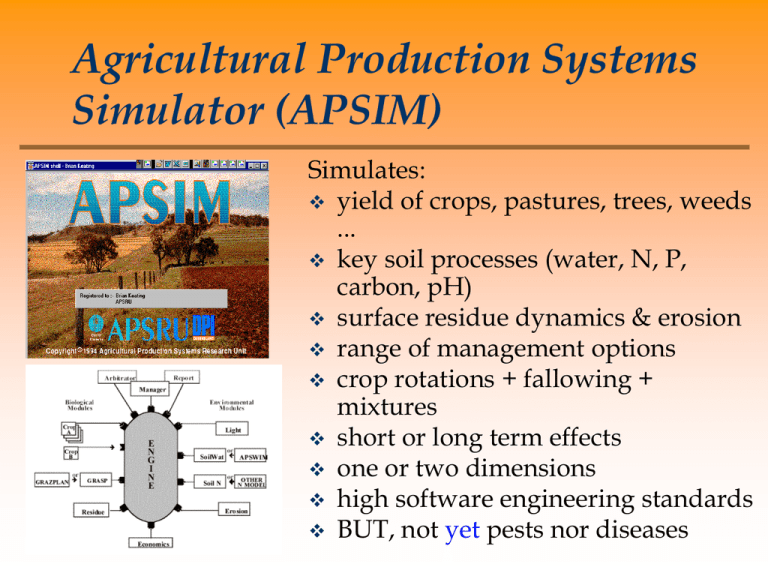apsim
advertisement

Agricultural Production Systems Simulator (APSIM) Simulates: yield of crops, pastures, trees, weeds ... key soil processes (water, N, P, carbon, pH) surface residue dynamics & erosion range of management options crop rotations + fallowing + mixtures short or long term effects one or two dimensions high software engineering standards BUT, not yet pests nor diseases APSIM - developmental goals Production Fate sought to retain yield prediction in relation to management options and environment (c/f - CERES, CROPGRO models) of the soil resource sought valid long-term simulation of key soil processes (c/f - CENTURY, EPIC) Impacts and profit off-farm predict loss of soil, water, nutrients off-site (c/f - EPIC) APSIM - some statistics Development team 7 programmers / model support staff 12 scientist / modellers User base 180 licensed users 9 countries, 4 continents Product Suite ca. 450,000 lines of code 4 languages 38 modules 12 interfaces or major tools Developing our knowledge & capability - APSIM modules Crop/pasture/tree wheat sorghum sugarcane chickpea mungbean soybean barley groundnut maize sunflower hemp lucerne fababean canola lupin mucuna cowpea Pinus radiata Eucalyptus sp. cotton - CSIRO PI pearl millet - ICRISAT pigeonpea - ICRISAT Soil SoilWat SWIM SoilN SoilP SoilpH Solute Residue Manure - ICRISAT Management Sowing Tillage Irrigate Fertilize Intercrop/mixture competition Multiple user interfaces – e.g. APSFront interface APSIM has been used to simulate … Some examples …physiological processes IC P L 87 180 15 160 14 140 120 13 100 80 12 60 40 11 IC R IS A T 1 9 9 0 / 9 1 20 IC R IS A T 1 9 9 2 H is s a r - 1 s t flo w e rin g 0 10 0 50 100 150 200 250 300 350 Da y o f y e a r Pigeonpea qualitative photoperiod response 400 Dayle ngth (h) Flow e ring tim e (DAS) c rit ic a l p h o t o p e rio d …plant organs T ille rs T o ta l 5 4 .5 4 .5 4 .5 4 4 4 3 .5 3 .5 3 .5 3 3 3 2 .5 L ai 5 L ai L ai M a in s te m 5 2 .5 2 .5 2 2 2 1 .5 1 .5 1 .5 1 1 1 0 .5 0 .5 0 .5 0 0 160 210 260 D ay 310 0 160 210 260 D ay Tiller leaf area in millet 310 160 210 260 D ay …crop growth & development 8 14000 tla i 7 L AI B IO M AS S To ta l D W la i 12000 to t_ b io m la i 6 b io m a s s 10000 s la i 5 8000 4 6000 3 4000 2 2000 1 0 0 0 20 40 60 80 100 120 140 160 180 200 450 0 20 40 60 80 100 120 140 160 180 200 120 140 160 180 200 14000 Leaf No. 400 L E AF NO G RAIN D W yie ld 12000 Node No. g ra in_ w t 350 g re e n_ le a ve s 10000 300 no d e _ no 8000 250 le a f_ no 200 6000 150 4000 100 2000 50 0 0 0 50 100 150 200 0 20 40 60 80 100 Growth & development of pigeonpea …yield of experimental crops Chickpea Cowpea 1200 yields 4500 2500 1:1 line 300 Grain (g/m2) 0 300 600 900 1200 Observed Prediction wheat grain maize grain chickpea grain mungbean grain cowpea grain stylo biomass 3500 3000 2500 2000 1500 y = 0.87x + 221.44 R2 = 0.77 1000 Biomass (g/m2) 0 Predicted Predicted Predicted 600 500 0 0 1000 2000 3000 4000 5000 y = 1.0631x - 70.964 2000 R2 = 0.7924 1500 1000 500 0 0.0 43 111 60 47 15 63 regression line slope 1.07 0.98 ( 0.04) 0.90 ( 0.07) 1.07 ( 0.10) 0.93 ( 0.08) 0.84 ( 0.06) 500.0 1000.0 1500.0 2000.0 2500.0 Observed Observed n 1:1 line regression 4000 900 Mungbean 3000 5000 R2 intercept -13.0 -5.5 ( 240) 163 ( 172) -27.2 ( 128) -31.6 ( 34.6) -131.7 ( 171) 0.79 0.85 0.76 0.72 0.91 0.78 3000.0 …yield of commercial crops Simulated v's farm yields 10 APSIM tested against data from commercial farms Crops include cotton, sorghum, mungbean, wheat, chickpea 9 8 Simulated yield (/ha) 7 6 5 4 3 SORGHUM 2 COTTON MUNGBEAN 1 1:1 line 0 0 1 2 3 4 5 6 Farm yield (/ha) 7 8 9 10 … yield of smallholder crops Maize response to N in Malawi Maize response to N & manure in Kenya Maize Grain Yield (Kenya, on-farm expts) G ra in y ie ld (k g /h a ) 4000 7000 3500 Predicted (k g/ha) 5000 4000 3000 2000 3000 2500 Clay SR97 Sand LR97 2000 1:1 line Clay SR96 1500 1000 Sand SR96 500 1000 0 0 0 0 1000 2000 3000 4000 5000 6000 7000 1000 2000 3000 4000 Measured (k g/ha) O bse rv e d Maize response to N at Makoholi B io m a s s a t m a tu rity (k g /h a ) Biomass at maturity (kg/ha) 14000 8000 12000 7000 10000 6000 8000 5000 Predicted S im u lated S imulate d 6000 6000 4000 4000 3000 2000 2000 0 1000 0 2000 4000 6000 8000 O b s e rv e d 10000 12000 14000 1:1 line 0 0 1000 2000 3000 4000 5000 6000 7000 8000 O bserved 1992-9 1991-92 5000 G rain yield (t/ha) G rain yield (t/ha) 5000 4000 4000 … N response in smallholder crops 3000 2000 1000 3000 2000 1000 0 0 -10 10 30 50 -10 70 Nitrogen a Nitrogen applied (kg/ha) 1992-93 1991-92 2000 1000 4000 3000 2000 1000 0 -1 0 10 30 50 -1 0 70 Nitro g e n ap p lie d (kg /ha) 1993-94 10 4000 3000 2000 1000 0 50 30 5000 G rain yield (t/ha) 3000 -10 Nitro g e n ap p lie d (kg /ha) 1000 3000 2000 1000 0 0 -1 0 10 30 50 -1 0 70 30 50 2000 1000 -10 70 10 30 3000 2000 1000 0 50 1996-9 5000 4000 -10 Nitro g e n ap p lie d (kg /ha) Nitro g e n ap p lie d (kg /ha) 70 10 30 50 4000 3000 2000 1000 0 -10 70 1995-96 1996-97 3000 2000 1000 0 -1 0 10 30 50 Nitro g e n ap p lie d (kg /ha) 70 5000 4000 G rain yield (t/ha) Grain yield (t/ha) Grain yield (t/ha) 1997-98 5000 4000 10 Nitrogen a Nitrogen applied (kg/ha) 5000 10 Nitrogen a G rain yield (t/ha) 2000 3000 1995-96 5000 4000 G rain yield (t/ha) Grain yield (t/ha) 3000 Testing simulation of maize response to N at Makoholi over 7 seasons 1991-1997 Nitrogen applied (kg/ha) 5000 4000 4000 0 70 10 1994-95 5000 1994-9 5000 G rain yield (t/ha) 4000 0 Grain yield (t/ha) 1993-94 5000 Grain yield (t/ha) Grain yield (t/ha) 5000 10 3000 2000 1000 0 -1 0 10 30 50 Nitro g e n ap p lie d (kg /ha) 70 4000 3000 2000 1000 0 -10 10 30 50 Nitrogen applied (kg/ha) 70 … seasonal perspectives Cumulative probability 1.00 0.80 0.60 0.40 0.20 -20 0.00 0 -10 10 20 30 40 50 60 70 Grain yield response to 30 kgN (kg grain/kg N) How representative were the seasons 91-98 at Makoholi? Average of Yield … yield of crops in rotation 7000 6000 Lines = predicted 5000 4000 Symbols = observed Sorghum Wheat w _yield 3000 2000 1000 0 15-Jun-94 s_yield 15-Jun-95 14-Jun-96 14-Jun-97 Average of LAI 6 Wheat 4 3 2 w _lai 1 s_lai 0 15-Jun-94 2000 Average of Biomass Sorghum 5 15-Jun-95 14-Jun-96 14-Jun-97 Sorghum Wheat 1500 1000 w_biomass 500 0 15-Jun-94 s_biomass 15-Jun-95 14-Jun-96 14-Jun-97 Wheat-Sorghum Long Fallow rotation … soil water of crops in rotation 240 220 Total Soil Water (0.1-0.5 m) mm 200 180 160 140 120 100 240 80 220 Total Soil Water (0.5-0.9 m) 200 mm 180 160 140 120 240 100 220 Total Soil Water (0.9-1.3 m) mm 80 200 180 160 140 mm 120 240 100 220 80 200 180 160 Total Soil Water (1.3-1.7 m) Wheat Sorgham 140 120 100 80 Wheat-Sorghum Long Fallow rotation 7/08/94 8/08/94 9/08/94 10/08/94 11/08/94 12/08/94 13/08/94 14/08/94 15/08/94 16/08/94 17/08/94 18/08/94 19/08/94 20/08/94 21/08/94 22/08/94 … ET of crops in rotation 450 Rain Measured ET Predicted ET Rain / Evaporation (mm) 400 350 300 250 200 150 100 50 0 01-Apr- 30-Sep- 01-Apr- 30-Sep- 01-Apr- 30-Sep- 31-Mar- 29-Sep- 31-Mar- 29-Sep- 31-Mar- 29-Sep93 93 94 94 95 95 96 96 97 97 98 98 Date 93 Wheat, 94-97 Lucerne measured in lysimeter … legume rotation effects Maize response (TBM) to fertiliser N following pigeonpea, India Vertisol Predicted 16000 Alfisol Measured 14000 12000 12000 10000 10000 8000 8000 6000 6000 4000 4000 2000 2000 0 0 P20_N0 P20_N40 P20_N80 Predicted 16000 14000 Measured P20_N0 P20_N40 P20_N80 … consequence of crop rotations Summary of crop contribution Cumulative drainage $400 1,200.00 W_W__S $350 $300 drainage W_WM_SC WS__C $250 Drainage (mm) Gross margin ($/ha/yr ) $GM W_W__SC 1,000.00 $200 $150 $100 800.00 W__S_S W_W W_W__S_S 600.00 W_WS_S 400.00 $50 200.00 _S 19 99 19 97 19 95 19 93 19 91 19 89 19 87 19 85 19 83 19 81 19 79 Rotation 19 77 0.00 19 75 S_ S W _W S W _W W _W __ S_ S W __ __ C W S _S C SC W _W M W _W __ W _W __ S $0 Year Wheat1 Wheat2 Mungbean Sorghum Chickpea Sorghum2 wheat_wheat/mungbean_sorghum/chickpea 7000 5000 Sorgh Chickp Mungb 4000 3000 2000 1000 0 19 72 19 73 19 74 19 75 19 75 19 76 19 77 19 78 19 79 19 79 19 80 19 81 19 82 19 83 19 83 19 84 19 85 19 86 19 87 19 87 19 88 19 89 19 90 19 91 19 91 19 92 19 93 19 94 19 95 19 95 19 96 19 97 19 98 19 9 Grain yield (kg/ha) 6000 wheat-wheat-mungbeansorghum-chickpea rotation Whea Year … soil organic matter changes Total Soil N (0-20 cm) 2200 1800 1400 Cropping 0 kg N/ha Cropping 40 kg N/ha Cropping 80 kg N/ha 1000 Lucerne Rotation 600 0 10 20 30 40 50 60 70 80 90 Years of cropping Farming systems on a vertisol at Dalby, Qld. 100 110 …crop-weed competition 24000 4 B io m a s s LA I 3 LAI Dr y w e ight 18000 12000 2 6000 1 0 0 352 12 37 62 87 112 352 12 Maize – volunteer stylo 37 62 87 112 …response to manure application S h o r t r a in s 3000 3000 2500 g rain yie ld (kg /h a) g rain yie ld (kg /h a) 2500 Lo n g r a in s 2000 1500 1000 F e rtilis e r H Q m a n u re 500 2000 1500 1000 500 L Q m a n u re 0 0 0 50 100 N r a te (k g /h a ) 150 0 50 100 150 N r a te (k g /h a ) High & low quality manure applied to maize … response to N, P fertilizer & manure Maize response to P rates in Kenya Biomass (g/m2) 1200 P0 P40 Response to N, P and manure, India P10 Pnon-lim Vertisol 12000 1000 Biom ass (kg/ha) 10000 800 600 400 Measured Predicted 8000 6000 4000 2000 200 1990.4 1990.6 Nx P N8 0 P2 0 an _B 1990.2 M 1990 Co nt ro l M an _A 0 1989.8 0 … “on-farm” constraints Agronomic efficiency (kg grain / kg N) 70 Response to 36 kg N/ha 60 50 40 30 20 10 0 Optimal agronomy / deep soil Good agronomy / shallow soil + weed pressure + late sowing + low Plant population … agroforestry systems Enabling landholder assessment of the productivity and risk of commercial agroforestry investment on grain farms in Australia’s medium to low rainfall regions Zones of influence in an agroforestry system II III 90 30 60 25 Stem Branch 20 Foliage 50 15 40 30 10 20 5 10 0 1982 1984 1986 Year 0 1988 0 Wheat Yield (kg/ha) 70 Foliage weight (t/ha) Stem/branch wt (t/ha) 80 IV Simulated wheat yields in zone III Mean, biggest & smallest responses Simulated wheat yields in zone II 5m high windbreak, 150mm in-crop rain 5000 5000 4000 4000 Grain yield (kg/ha) I Simulated tree growth in zone I 3000 2000 1000 3000 2000 mean 1980 1978 1000 0 0 5 Grain yield 0 1 2 3 4 10 15 Distance from trees (H) 5 20 Distance from windbreak (tree heights) 0 25 10 20 Distance from trees (H) … change in wheat production under climate change Yield response (%) 50 40 Rainfall change 30 20% 0% 20 -20% 10 0 0 1 2 3 -10 Temperature increase (o C) 4 … but can you use such technical information with farmers? YES…but the information needs to be made relevant to farmers’ realities Source: Peter Carberry CSIRO, Australia Click the back button on your browser to return to the main menu







